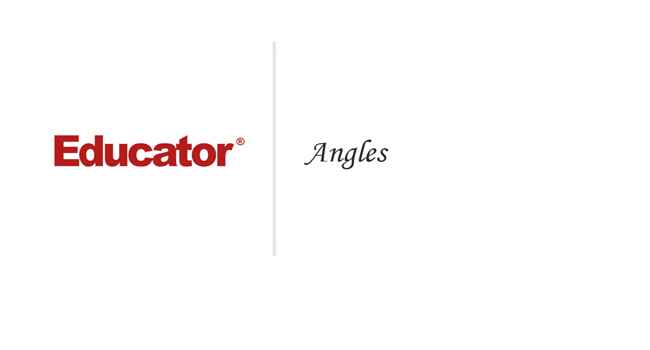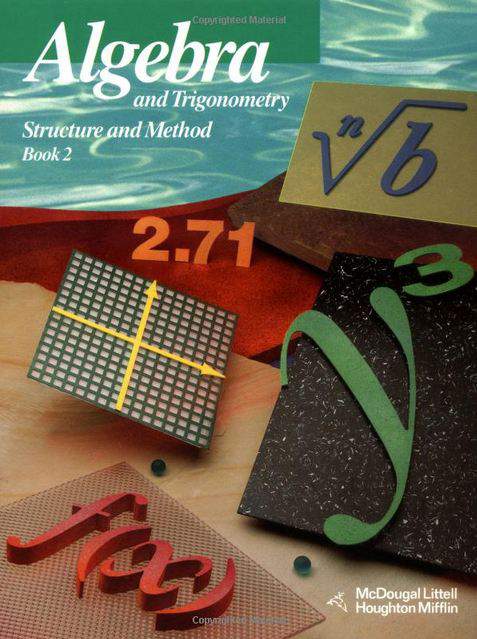
This is a quick preview of the lesson. For full access, please Log In or Sign up.
For more information, please see full course syllabus of Trigonometry
For more information, please see full course syllabus of Trigonometry
Trigonometry Angles
Lecture Description
There are two ways to measure angles: degrees and radians. When measuring in the degree unit, a circle is 360 degrees, a semicircle is 180 degrees, and a right angle is 90 degrees. And when measuring in the radians unit, a circle is 2π radians, half a circle is π radians and a right angle is π/2 radians. Fortunately, there are formulas for converting between the degrees and the radians, and you'll have the opportunity to practice those conversions and learn more about them through the examples. Additionally, in this lecture, you'll learn about complementary and supplementary angles, and what coterminal angles and quadrants are.
Bookmark & Share
Embed
Share this knowledge with your friends!
Copy & Paste this embed code into your website’s HTML
Please ensure that your website editor is in text mode when you paste the code.(In Wordpress, the mode button is on the top right corner.)
×
- - Allow users to view the embedded video in full-size.
Next Lecture
Previous Lecture










































 Answer Engine
Answer Engine




2 answers
Last reply by: Jimmy Luo
Tue Jun 8, 2021 6:58 PM
Post by Jimmy Luo on June 1, 2021
What grade would you normally learn this in?
2 answers
Last reply by: Hong Yang
Sun Jan 31, 2021 8:19 AM
Post by Hong Yang on January 2, 2021
Hello Professor Murray,
First of all, I wanted to say that you are a very good teacher. You make everything more clear, so thank you! Second of all, can you tell me what grade this is for?
Thanks again!
1 answer
Wed Mar 18, 2020 10:20 AM
Post by Star Du on March 16, 2020
How can radians be negative?
1 answer
Fri Nov 3, 2017 6:37 PM
Post by Julius Francis on November 1, 2017
Do you recommend any Trigonometry Workbooks?
1 answer
Tue Jul 18, 2017 8:32 AM
Post by Mohamed E Sowaileh on July 10, 2017
Hello Dr. William Murray,
I hope you are very well.
I am a student who is extremely weak in math. In order to be very strong in math, specially for engineering field, could you provide me with sequential order of mathematical topics and textbooks. With what should I begin so that I can master big topics like calculus, statistics, probability ... etc.
Your guidance is precious to me.
Thank you so much.
1 answer
Sat Mar 18, 2017 11:56 PM
Post by Anna Kopituk on March 15, 2017
I am taking this as a home school student. How can I be tested on this material and come up with a grade?
1 answer
Mon Jan 9, 2017 10:20 AM
Post by Anish Srinivasan on January 8, 2017
Is there a complement and supplement of a negative angle, and can there be a complement angle of an angle greater than 90 degrees? Also, can there be a supplement angle of an angle greater than 180 degrees?
3 answers
Mon Nov 7, 2016 11:39 AM
Post by Firebird wang on November 2, 2016
Professor, I know that AP Statistics is not your subject, but I just wonder if you are able to watch the two videos which called Practice Test 2013 AP Statistics an Practice Test 2014 AP Statistics in the AP Statistics content? Both videos showing network error, I dont know why. I already tried in different computers already.
2 answers
Mon Jun 13, 2016 8:53 PM
Post by Tiffany Warner on June 10, 2016
Hello Dr. Murray,
I see lots of comments regarding practice problems and such, but I see no link for them like I did with other lectures. Your examples in the video were definitely helpful for making the concepts sink in, but I do like to do practice problems every once in awhile to test myself and see if I really got it. Did they take them away?
Thank you!
1 answer
Fri Oct 30, 2015 4:23 PM
Post by Alexander Roland on October 30, 2015
Hello Professor,
If you don't mind sharing, what type of technology is that you are using to deliver instructions?
Thanks for sharing
4 answers
Wed Jun 17, 2015 10:18 AM
Post by Ashley Haden on April 29, 2015
It seems a bit confusing that radians are 2PIR. Why isn't there a symbol for a radian, or just for 2PI?
1 answer
Mon Aug 4, 2014 7:31 PM
Post by Tehreem Lughmani on July 9, 2014
Example 3 how to know what is between 0-2pi? I'm not good with fractions :)
1 answer
Mon Aug 4, 2014 7:13 PM
Post by Tehreem Lughmani on July 9, 2014
Example 3 - C. -586+360= -226+360= 134???
-226+360= 94
I get this answer every single time~ what's wrong here -.-|||
1 answer
Wed Oct 9, 2013 5:48 PM
Post by Rakshit Joshi on October 7, 2013
How to download the notes??
1 answer
Wed Oct 9, 2013 5:47 PM
Post by Rakshit Joshi on October 6, 2013
Sir you are AWESOME!!
1 answer
Wed Aug 14, 2013 12:53 PM
Post by Reema Batra on August 1, 2013
I found errors in questions 6 and 7 in the practice problems...
1 answer
Wed Aug 14, 2013 12:53 PM
Post by Reema Batra on August 1, 2013
For the sixth practice problem, I found an error:
Question - Determine which quadrant the following angle is in and find a coterminal angle between 0 and 360: 450.
My Answer: 90; y-axis.
The Answer Given: 115; Quadrant 2. This also had 450-360 is 115. This is incorrect, if I am not mistaken...
1 answer
Fri Jul 5, 2013 9:57 AM
Post by mohammad sawari on July 5, 2013
what is call the half of the radius
1 answer
Fri Jul 5, 2013 9:55 AM
Post by Norman Cervantes on July 1, 2013
second time going through this course. going straight to the examples, this course is very well taught. it really gives my brain a workout!
1 answer
Mon Jun 10, 2013 7:34 PM
Post by Dr. Son's Statistics Class on June 10, 2013
You're a great professor!
1 answer
Mon Jun 10, 2013 7:33 PM
Post by Jorge Sardinas on June 8, 2013
i am 9
3 answers
Sat Jun 8, 2013 5:44 PM
Post by Manfred Berger on May 29, 2013
Could you elaborate a bit on what the motivation behind using signed angles is? Quite frankly I fail to see a functional difference between an angle -x and x+180 degrees.
3 answers
Wed May 29, 2013 11:17 AM
Post by Manfred Berger on May 28, 2013
Your Rs look a lot like exponents. Is that a general notation or just your handwriting?
1 answer
Thu Apr 25, 2013 3:04 PM
Post by Edmund Mercado on April 15, 2012
A very fine presentation.
1 answer
Thu Apr 25, 2013 3:02 PM
Post by Levi Stafford on March 19, 2012
commenting on the text on the quick notes.
"2Ï€ parts, denoted 2Ï€ R." the pi's look like "n's" and it is confusing...I thought they were variables.
1 answer
Thu Apr 25, 2013 2:59 PM
Post by kirill frusin on March 2, 2012
I believe you confused compliment and supplement in one of your videos. The video I watched before this about RADIANS says supplement is two angles added to be 90 degrees and complimentary add to 180 degrees.
1 answer
Thu Apr 25, 2013 2:53 PM
Post by Janet Wyatt on February 10, 2012
Is there practice worksheets I can print?
1 answer
Thu Apr 25, 2013 2:50 PM
Post by Valtio Cooper on January 14, 2012
Great lecture! I got it but I'm having a problem with a question that I got for homework pertaining to this topic! I was wondering if i could be given some guidelines if possible please.
The question is:
A Hexagon is inscribed in a circle. if the difference between the area of the circle and the area of the hexagon is 24meters squared use the formula for the area of the sector to approximate the radius of the circle.
1 answer
Thu Apr 25, 2013 2:18 PM
Post by Kyle Spicer on December 6, 2011
where do you take the assessment test? I can't find it.
1 answer
Thu Apr 25, 2013 2:16 PM
Post by Robert Reynolds on October 22, 2011
Thumbs up for 2 things:
1. Assessment test at the beginning to find where you are at now.
2. End of lesson tests.
That make this site the Deathstar of education. (Without the silly hole that you can shoot down and blow the whole thing.)
1 answer
Thu Apr 25, 2013 2:15 PM
Post by David Burns on August 8, 2011
I wish this site had tests available, or at least links to them. Other than that I love it here.
1 answer
Thu Apr 25, 2013 2:12 PM
Post by Sheila Greenfield on March 3, 2011
i get this and i'm a freshman in high school i really like this cant wait to learn more
1 answer
Thu Apr 25, 2013 2:10 PM
Post by Erin Murphy on March 16, 2010
You are a fantastic prof. On to my next lesson!